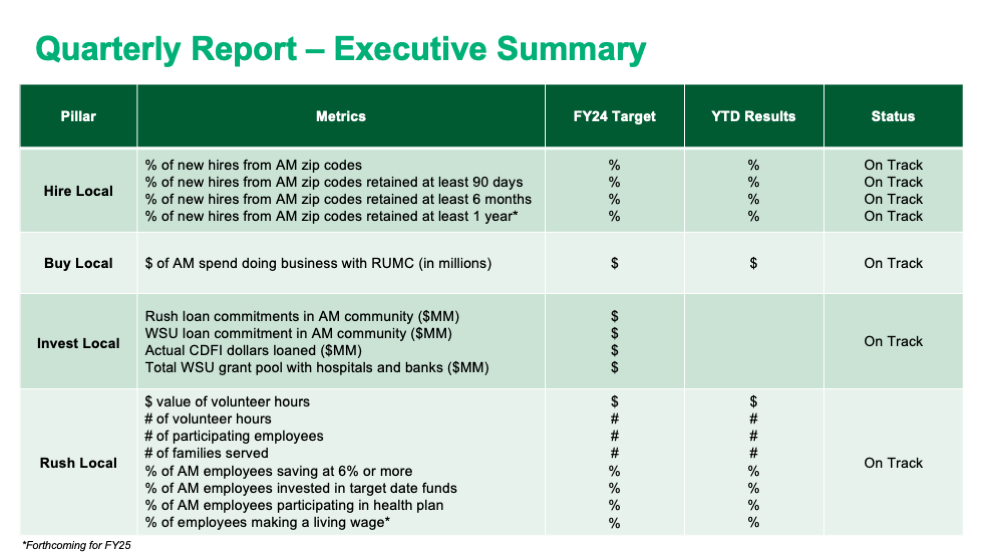Section 5|Updates on Data Framework, Reporting Structures, and System Integration
5.1 Standardizing and Integrating Data Collection
Rush’s data framework has evolved significantly in the years following the publication of the original Anchor Mission Playbook. It is therefore worthwhile to note the ways in which Rush has standardized data collection and analysis and brought these standardized practices to its satellite hospitals as part of its system integration process.
5.2 Data Collection Framework
|
It is helpful to create and consistently edit a master data management framework that outlines metrics, data sources, and reporting cadences for all anchor initiatives. A template for that data management can be found here. A data collection framework outlines the data that the anchor mission department analyzes along with a schedule of when data reporting is due for internal and external audiences. |
|
Implementing standardized metrics with consistent reporting timelines improves the sustainability of anchor mission initiatives over time. Standardization is also necessary when implementing an anchor mission across a hospital system that includes hospitals in different locations. The standard metrics for Rush can be found here. These have grown and evolved over time in alignment with metrics collected for Rush's Community Health Needs Assessment (CHNA) and Community Health Improvement Plan (CHIP), and metrics already collected by business departments. |
|
|
Creating templates for business units to report on their progress allows for consistent reporting that does not create an organizational burden on business leads. Rush uses standard templates for business leads to submit quarterly data and describe activities they have engaged in to support anchor mission strategies.
|
5.3 System Integration
Once a data framework is established, Rush’s experience was that the most feasible initiatives to pursue when it was beginning its anchor mission journey and trying to integrate the anchor mission across the system was within human resources and employee benefits and volunteerism (both of which typically reside in the human resources department).
As discussed in the original Anchor Mission Playbook, anchor mission implementation often begins with data analysis based on anchor mission-specific metrics in order to benchmark the current state of each department before pursuing anchor mission initiatives. Rather than determining new metrics for each system hospital based on their data collection practices, it is more efficient to adhere to one to two standard metrics already being collected by the original hospital engaged in anchor mission work. The original Anchor Mission Playbook provides an overview of potential metrics that can be tracked in order to assess impact. In Rush’s experience, being selective and intentional (only choosing one to three metrics to track that are also directly related to the anchor mission activities that will be undertaken) is the most efficient way to track progress over time without creating undue reporting burdens for business leads.
For example, looking up the amount of local hires based on their geographic location can be easily accomplished by a data pull from an applicant tracking system (which human resources departments rely on to hire employees). Thus, it is a consistent metric that hospitals can track across the wider system. It can also be directly correlated with the activities that a talent acquisition team undertakes such as recruiting applicants at hiring fairs, hosting community hiring events, and partnering with a community organization to interview referred applicants.
It is important to note that some initiatives will require more exploration and data assessments in order to fully integrate them into the scope of anchor mission strategies. Some obstacles hospitals can face are logistical, such as using different data tracking systems (e.g., one hospital uses Workday and another uses iGreentree as an applicant tracking system (ATS) or one uses supplier.io and another uses Supplier Gateway for Tier II spend tracking). Other obstacles are organizational; there may be a hesitation of satellite hospital staff to adhere to the main hospital’s impact tracking structure and anchor mission methodology, especially if it does not easily align with their community health or philanthropic initiatives.
To address these obstacles, standardization is key, but flexibility is important—having a specific ask of metrics and reporting creates a starting point for initial anchor mission conversations, but allowing each hospital to select what they can feasibly track and along what timeline creates a more dynamic structure that can evolve as resources are developed to support anchor mission efforts. Once metrics are selected, a reporting cadence should be established, and monthly, quarterly, and annual options are the ones most common to allow for intentional analysis of progress over time. Timelines for reporting should allow for flexibility and can be interchangeable across different hospitals without impacting reporting structures.
5.4Field Perspective System Integration at Rush
Rush has begun the process of integrating the community health equity and anchor mission initiatives of Rush Oak Park Hospital and Rush Copley Medical Center in the broader anchor mission framework of Rush University System for Health. System integration efforts began with identifying key stakeholders in anchor mission implementation at each hospital and providing them with an anchor mission overview led by Rush’s anchor mission team. After that, the team assisted both hospitals with determining focus geographies(based on factors like the life-expectancy gap, areas with high patient volume, and areas with the lowest median income) for Oak Park and for Copley and determining metrics to track annually. Once targets were set, Rush incorporated anchor mission metrics within the Senior Leadership Team Corporate Dashboard, which is closely monitored by senior executives at all three hospitals. This ensured that anchor mission system integration aligns with the larger strategic priority of standardizing practices to improve the coordination of care at all three Rush System hospitals.


